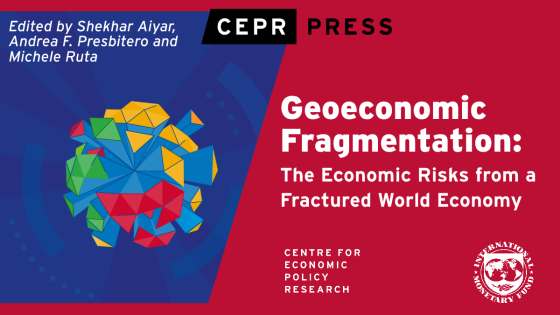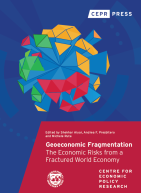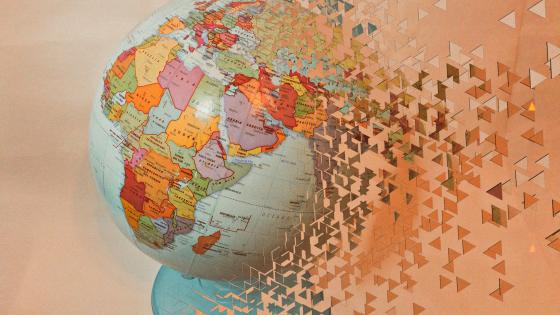The economic costs of fragmentation
The economic costs of geoeconomic fragmentation are difficult to understate. As discussed by several contributions in the eBook, estimates vary widely and are highly uncertain. But despite their modelling differences, these studies have three main conclusions:
- Adjustment costs from geoeconomic fragmentation are likely to be large, with the costs mounting the more severe the fragmentation scenario considered.
- The economic costs associated with trade restrictions are greatly amplified by technological decoupling.
- Emerging market economies and low-income countries are likely to be most at risk due to the loss of knowledge spillovers.
Depending on modelling assumptions, the cost to global output from trade fragmentation could range from 0.2% (in a limited fragmentation/low-cost adjustment scenario) to up to 7% of GDP (in a severe fragmentation/high-cost adjustment scenario). With the addition of technological decoupling, the loss in output could reach 8% to 12% in some countries. The fragmentation of FDI flows, could substantially add to global output losses (IMF 2023c). And so could numerous other channels – such as further restrictions on cross-border flows of human capital, and the failure to cooperate on the provision of global public goods – which have not, to date, been adequately modelled even on a stand-alone basis, let alone in combination with other channels.
The cracks in the system
The risks of geoeconomic fragmentation can seem at odds with aggregate statistics. Even when we look at trade between China and the US, where the relationship is politically fraught, we still observe that US imports from China in 2022 were over 30% higher than in 2017. Financial flows, too, are still very integrated. For instance, even if the momentum has slowed since the global financial crisis, cross-border external positions have expanded sharply since the 1990s. And portfolio investment from major economies into China was still on the rise in 2021 (IMF 2023a).
Although we are not (or not yet) in a fragmented world, we are observing important cracks in the system.
First, policies are changing. If we look at trade policy, the share of G20 imports that is affected by trade restrictive measures increased from around 2% in 2011 to close to 12% ten years later (IMF 2023b). We are also witnessing a return of industrial policy (Juhász et al. 2023). Available data indicate that since January 2023 alone, 1,340 new industrial policy interventions were recorded, the majority of which were various forms of subsidies implemented by G20 economies (Evenett et al. 2023). More concerning is that the path we are embarking on can easily lead to unintended fragmentation. All ‘policy signals’ – trade policy, industrial policy, security policy – point in the same direction.
Second, when we look at the data more closely, we already see important changes. The US-China trade war is reshuffling trade patterns. Because of the tariffs, US imports of Chinese goods subject to the 2018-2019 tariffs were 12.5% lower in 2022 than in 2017 – as shown by Freund et al. (2023). They also find no significant evidence of improved diversification, with China being primarily replaced by individual exporters, such as Vietnam and Mexico, that are intricately linked to China’s supply chains. Alfaro and Chor (2023) confirm these findings and document the surge in the US of unit import prices from these alternative source countries, providing first indirect evidence of the rising costs of fragmentation. Similarly to these new insights from goods trade flows, other recent work at the Fund (Aiyar et al. 2023b, IMF 2023a) documents early signs of fragmentation in capital flows, which are increasingly concentrated among geopolitically aligned countries.
How things will evolve is difficult to predict. Sanctions and trade barriers are difficult to enforce over the longer term. The impact is sharp at first, because the elasticity of substitution is lower; but economies adapt – the experience of Europe dealing with Russian gas is a case in point.
Where do we go from here?
What research could do to sharpen our understanding of the risks from geoeconomic fragmentation and offer tools to policymakers to find cooperative solutions? In our view there are three key areas:
Modelling
On the modelling side, there are two gaps. First, quantitative structural trade models used for the assessment of the costs of fragmentation mostly feature static or long-run steady-state equilibria, and thus are unable to offer insights on transitional dynamics. Likewise, the literature is only starting to fully account for the network structure of global value chains (GVCs), which is critical to better identify the transmission mechanism from potential fragmentation (Antras and Chor 2022). By contrast, dynamic stochastic general equilibrium (DSGE) models developed in the open economy macroeconomics literature are well suited to explain transitional dynamics, but their lack of granularity – often abstracting away from global input-output linkages – leads to the omission of possibly very important inter-industry and cross-country spillover effects. So, narrowing the gap between these two strands of the literature is hard, but essential.
The second gap has to do with the partial equilibrium nature of current assessments of fragmentation. Models focus on one (or a few) transmission channel(s) of fragmentation, while other relevant channels are shut down. These channels, however, do not operate in a vacuum and are likely to be connected. It is critical – but difficult – to understand how they interact, as they could trigger fragmentation along other dimensions and reinforce each other, leading to more adverse outcomes. For instance, some of the estimated losses from trade fragmentation are likely to be multiplied once one considers reductions in labour flows and capital flows, and a deterioration in the provision of global public goods. Being able to incorporate impacts through different channels in quantitative models will be essential to generate more realistic scenarios.
Empirics
Closely monitoring early signs of fragmentation can help policy makers to understand the intended and unintended consequences of trade and industrial policies. For instance, while trade restrictions are indeed having a significant effect in reshaping global supply chains, these effects may be quite different from what the measures intend to achieve. US tariffs on China have reduced efficiency and increased prices in the US (Fajgelbaum and Khandelwal, 2022), but as shown in Freund et al. (2023), they have so far not helped to improve the diversification of import sources – a stated goal of the measures. Learning from early evidence can contribute to improved policies.
Better and more convincing evidence can only come from more micro-level data. Transaction-level customs datasets merged with firm-level or bank-firm matched datasets have become increasingly available, enriching empirical evidence on the behaviour of exporters and importers, which in turn has helped improve the calibration of quantitative models. Similar, more granular data on capital flows are becoming available, but much more is needed. When administrative data are not available (or accessible), alternative data (e.g. shipping data) and big micro-level data with high frequency indicators can greatly improve our capacity for real-time analytics.
Policy
The most significant change in recent times has been the growing activism on the policy front, including trade policy, industrial policy, and climate policy. This activism is justified in some cases, but also poses many challenges. Some of these policies generate strong negative spillovers, intended or not. And there is a manifest risk that these measures will lead to retaliation and further policy escalation and uncertainty. Monitoring policies, assessing their (intended and unintended) economic implications and cross-border spillover effects is a priority. Structural trade models can be used to assess the effects of different policy scenarios in an attempt to identify those policies that achieve intended domestic goals while minimizing the disruption to trade partners.
The goal of research and international institutions cannot be limited to monitoring policies and quantifying their effects. There is a need to find solutions to underlying problems. This is why the IMF is calling for stronger multilateral efforts to resist geoeconomic fragmentation (Aiyar et al. 2023). When multilateral efforts stall, open and non-discriminatory plurilateral initiatives could be a practical way to advance cooperation. When countries opt for unilateral actions, credible ‘guardrails’ may be needed to mitigate global spillovers and protect the vulnerable. Economic analysis can help identify policy solutions. There is a long tradition of using game theory and mechanism design to study the efficiency of rules in trade agreements (Bagwell and Staiger 2016). This approach can be used to answer difficult questions, from the design of green subsidy schemes to guardrails on the use of export controls to achieve food or national security.
Conclusions
This eBook is an attempt to conceptualise a new threat to the global economy and take stock of the best available research to date on the subject. It clarifies what we know and what we don’t, thus lighting the path for future research. But it is just a first step. One thing is clear: a great deal more work is needed. The research community has a crucial role to play in informing the debate and suggesting policies to promote multilateral cooperation and help avert escalating geoeconomic fragmentation.
Authors’ note: The views expressed here are those of the authors and should not be attributed to the International Monetary Fund, its Executive Board, or its management.
References
Aiyar, S and A Ilyina (2023), “Geoeconomic Fragmentation and the World Economy”, VoxEU.org, March.
Aiyar, S, J Chen, C Ebeke, R Garcia-Saltos, T Gudmundsson, A Ilyina, A Kangur, T Kunaratskul, S Rodriguez, M Ruta, T Schulze, G Soderberg and J Trevino (2023a), “Geoeconomic Fragmentation and the Future of Multilateralism”, IMF Staff Discussion Note, SDN/2023/01.
Aiyar, S, D Malacrino and A Presbitero (2023b), “Investing in Friends: The Role of Geopolitical Alignment in FDI Flows”, CEPR Discussion Paper No. 18434.
Aiyar, S, A Presbitero and M Ruta (eds) (2023c), Geoeconomic Fragmentation: The Economic Risks from a Fractured World Economy, CEPR Press.
Alfaro, L and D Chor (2023), “Global Supply Chains: The “Looming” Reallocation”, NBER Working Paper No. 31661.
Antras, P and D Chor (2022), “Global Value Chains”, in G Gopinath, E Helpman, and K Rogoff (eds), Handbook of International Economics, Vol. 5, Elsevier.
Bagwell, K and R Staiger (eds) (2016), Handbook of Commercial Policy, Elsevier.
Evenett, S, A Jakubik, F Martin and M Ruta (2023), “The Return of Industrial Policy in Data”, mimeo, International Monetary Fund.
Fajgelbaum, P D and A K Khandelwal (2022), “The Economic Impacts of the US-China Trade War”, Annual Review of Economics 14: 205-28.
Freund, C, A Mattoo, A Mulabdic and M Ruta (2023), “Is US Trade Policy Reshaping Global Supply Chains”, paper presented at the IMF conference on Geoeconomic Fragmentation, May.
Goldberg, P K and T Reed (2023), “Growing Threats to Global Trade”, Finance and Development, June.
IMF – International Monetary Fund (2023a), “Geopolitics and Financial Fragmentation: Implications for Macro-Financial Stability”, Chapter 3 in Global Financial Stability Report, April.
IMF (2023b), “Review of the Role of Trade in the Work of the Fund”.
IMF (2023c), “Geoeconomic Fragmentation and Foreign Direct Investment”, Chapter 4 in World Economic Outlook, April.
Juhász, R, R Lane and D Rodrik (2023), “The New Economics of Industrial Policy”, Annual Review of Economics 16.
Ottaviano, G, P Stanig and I Colantone (2021), “The globalisation backlash”, VoxEU.org, November.








